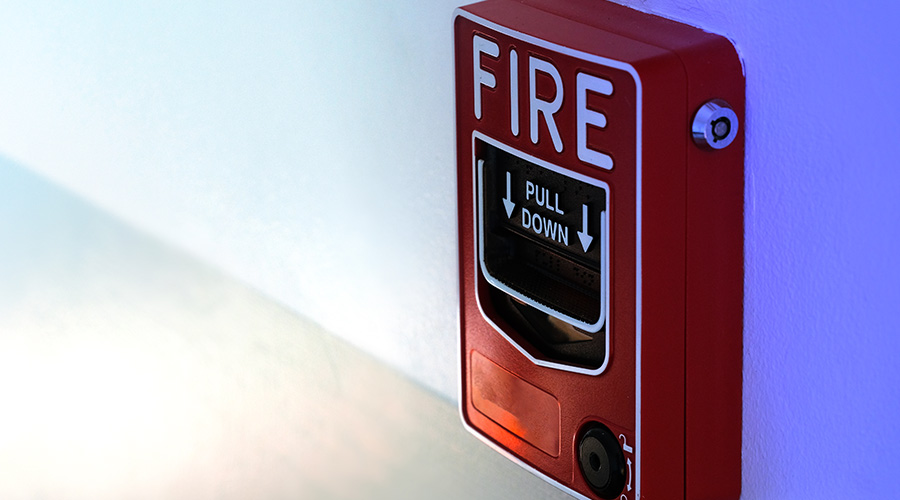Performance-Based Fire Safety Design
A new design approach provides flexibility but requires facility executives to exercise care in planning future building modifications
At facility design or renovation project meetings, a relatively new concept is coming up during discussions about fire safety: performance–based design. Performance-based design is becoming more common as facilities incorporate unique features to achieve aesthetic, cost and functional goals while maintaining safety levels for building occupants and emergency responders. Design teams are finding that performance-based design provides the flexibility to maintain safety while using progressive design that might otherwise have been restricted by stringent enforcement of building code requirements.
As performance-based designs become more common, however, they present a special challenge to facility executives: maintaining fire protection features during future operations, maintenance or renovation work.
The easiest way to understand the concept of performance-based design is to start with the traditional prescriptive-based design. Building codes have typically prescribed specific design criteria, such as the number of exits or the number of feet to an exit; these are numeric criteria that can be easily measured.
By contrast, a performance-based code allows the use of any design that demonstrates compliance with the fire safety goals of the code. Those fire safety goals are explicitly spelled out in the code, as are methods that can be used to demonstrate compliance. A performance-based design starts with an analysis of fire scenarios to determine which design alternatives will meet those fire safety goals.
Performance-based provisions can be found in a variety of codes and standards, including:
Performance-based provisions have been allowed for some time but are now recognized specifically in code text. Previously, performance-based approaches were typically referred to as either “Alternate Means and Methods” or “Equivalencies.”
The building codes and the Life Safety Code have similar egress requirements and provide examples of prescriptive requirements. Some common means of egress limitations include:
- A 300-foot maximum travel distance in a fully sprinklered office building, per NFPA 101.
- Two required exits from an assembly occupancy with an occupant load of greater than 50 people, per the International Building Code (IBC).
- Three required exits for a floor area with an occupant load greater than 500 people, per NFPA 1.
The prescriptive requirements are set numbers that may not account for the variability encountered nowadays in construction methods and features. The prescriptive requirements of NFPA 101, for example, simply state that a travel distance of 299 feet, 11 inches in an office building is acceptable, but 300 feet, 1 inch is not.
Similarly, under the IBC, only one exit is needed in a conference room with an occupant load of 49, whereas when an extra person is added to the occupant load, two exits are required. The same line is drawn between 500 and 501 people in a floor exit scenario in NFPA 1. Prescriptive code requirements are meant to encompass the majority of occupancies and building situations, drawing upon past loss history and standard construction methods.
Intent of the Code
In comparison, performance-based requirements delve into the main purposes of the numerical prescriptive requirements to determine the intent of the code. The same requirements from a performance-based perspective might look something like this:
- Provide a maximum travel distance over which safe conditions for egress — technically known as tenability — can be maintained for building occupants throughout the egress period. (Tenability is most commonly defined as parameters that indicate the ability of building occupants to escape from a building during a fire. Examples of these parameters can include visibility, carbon monoxide levels and temperature.)
- Provide a sufficient number of exits from an area of generally high density occupant load to allow for safe egress, where the determination has been made that only a single means of egress presents an unacceptable risk.
- Provide a sufficient number of exits from a floor area where the large number of people need more than two exits from the area in the event of an evacuation.
The performance-based approach affords the design team greater flexibility than the prescriptive code requirements. The maximum travel distance is flexible, depending on the method used to maintain tenability along the means of egress. Tenability might be maintained for a distance significantly longer than 300 feet in a building where neither radiant heat transfer nor a descending smoke layer are an issue, such as in a building with an extremely large atrium. Other fire protection features may also be used in meeting the performance criteria for multiple exits, both from specific occupancies — such as assembly — or general floor areas. Examples include an increased number of separations, such as a demising wall between tenant spaces, or an increase in the fire-resistance ratings of those separations. Other examples include modified smoke control configurations and means of egress arrangements, such as more exits or different exits to reduce travel time, resulting from timed egress analyses.
It should be noted that codes recognize a variety of performance-based provisions. One example is the approach taken to smoke-control design and design fire determination. IBC Section 909 uses both prescriptive- and performance-based approaches. The section allows a designer to use performance-based calculations to determine the size of a design fire and subsequent smoke production rates, where the prescriptive minimum fire size may not adequately reflect the actual design conditions.
Long-term Impact
By using performance-based design, the design team can achieve goals that may not have been anticipated by the building code, while maintaining or exceeding the facility’s required level of safety. However, these benefits do not come without strings attached. It is important that a facility executive have a thorough understanding of a building’s performance-based design concept because of the potential implications of the design for future renovations and additions.
During initial facility design, the performance-based approach will be reflected in design documentation. The form this documentation takes will most likely vary depending on the jurisdiction in which the facility is located. It may be as simple as an alternate means and method request — which is the most common current application of performance-based design and concerns a single building design aspect — or as complex as a full fire protection/life safety report that documents all fire protection/life safety aspects.
The more documentation required during the design process by the authority having jurisdiction — typically a building official — the more likely design documentation will be maintained through the life of the building. With design documentation to refer to in future renovations, it is less likely assumptions behind a performance-based design will be compromised.
In some jurisdictions, the building department requires sufficient documentation for just this reason — to maintain all design assumptions that may affect occupant safety. For instance, a fire protection/life safety report may be used following construction to document building design parameters through the life of the facility, much like a building operations and maintenance manual. Formal discussions about an operations and maintenance manual can be found in the Users Guide to the ICC Performance Code for Buildings and Facilities and the SFPE Engineering Guide to Performance-Based Fire Protection Analysis and Design of Buildings.
When renovations are proposed, it is necessary to understand the previous design assumptions and to maintain them throughout the life of the building. Typically, when attempting to analyze an existing building for renovation impacts, the design professional will use the building’s construction date to review the code of record — the building code under which the building was originally built. The code of record establishes the primary requirements that the facility was meant to meet.
Reviewing the code of record establishes the fire protection/life safety features that would be anticipated during a field survey. But if the field survey finds fire protection provisions that exceed those required by the code of record, it could be erroneously assumed that the measures were inadvertently utilized, rather than being essential to a performance-based design. If that were the case, those features might be compromised during subsequent building modifications because their importance is not understood.
Putting it to Use
A performance-based design may incorporate any number of fire protection features. Here are four examples of common fire protection features used in performance-based designs.
1. Reduce sprinkler activation temperatures or decrease spacing to decrease anticipated fire sizes by reacting more quickly to a fire. As discussed previously, travel distances can be equated to a period during which tenability or safe conditions for egress is maintained for building occupants. Tenability can be measured through a number of parameters, the most common of which are temperature, carbon monoxide concentration and visibility.
The standard temperature rating for an automatic sprinkler for a normally ventilated building is 165 F (or “ordinary” temperature as defined by NFPA Standard #13, Standard for the Installation of Sprinkler Systems). A standard sprinkler will respond more slowly to a fire than a sprinkler having a quick response rating, all other factors being equal. Specifying either a lower temperature sprinkler or a quicker response thermal element will reduce sprinkler response time.
Faster sprinkler response time means a smaller fire, which minimizes both smoke production and heat release rates. Both have a direct impact on tenability measures, as a smaller fire results in less smoke and heat and fewer products of combustion. Decreasing fire sizes in relation to those anticipated by standard code may offer the opportunity for increased travel distances or other unique facility features.
2. Increase sprinkler densities to limit fire sizes or provide additional fire-resistance to building structural members. Increased sprinkler densities have also been used in lieu of a required fire-resistance rating. A typical application of this concept is an approved water curtain that provides a one-hour fire-resistance rating. NFPA 13 also recognizes the utilization of column-spray sprinklers in storage occupancies in lieu of cementitious spray-on fireproofing. These approaches may be used in modified forms to provide additional fire resistance where straightforward methods of compliance are unattainable.
3. Use additional fire barriers in lieu of reduced construction types. Both the IBC and NFPA 5000 restrict allowable areas (square footage) based upon construction type. These areas are required to be separated from one another by fire walls, which in many cases have four-hour fire-resistance ratings. Where it is desired to exceed the overall allowable area for a given construction type, additional two-hour rated fire partitions — so-called “party walls” — may be used in lieu of the four-hour fire walls. This is done in conjunction with statistical analysis to justify that the modified construction approach provides an equivalent level of anticipated risk. These additional fire partitions would not be identified as necessary building components without the documentation associated with a performance-based design.
4. Conduct timed egress analyses. A timed egress analysis may require additional measures in lieu of standard fire protection features to increase travel distances or to minimize number of exits. Timed egress accounts for the fact that not all building occupants will reach an exit door simultaneously, allowing a design team to analyze specific architectural features. Additional doors or different-width components (for example, exit ramps, stairwells or doors) that exceed the prescriptive requirements of the code may be used in these analyses to provide ample occupant flow to meet the design criteria.
These examples provide a brief overview of how performance-based design fire protection features might be incorporated into a facility design. These features are limited only by the imagination and ability of the design team, coupled with the willingness of the code officials to accept an unorthodox approach. The features typically used are also likely to change as new technologies are introduced, both in terms of methods of implementation and analysis.
Eye on the Future
Performance-based design allows for significant design flexibility; however, therein lies a great responsibility to maintain fire protection features that might be beyond those normally required by code. Without knowledge of the mitigating features, a well-intentioned contractor or designer could compromise the building’s safety during future renovations.
It is essential that the facility executive be aware of the performance-based measures used in a facility and that someone serve as the caretaker of these fire protection/life safety strategies.
When renovations are proposed, existing performance-based fire protection features have to be accounted for as much as prescriptive-based requirements — the main difference being that prescriptive-based requirements are more apt to be commonly recognized. They do not tend to differ significantly from building to building. For example, stairwells in high-rise buildings are typically provided with a two-hour fire resistance rating. It is more difficult to identify the decreased sprinkler spacing provided as a component of a performance-based design without the design basis paperwork that accompanies such a design.
The documentation behind these designs provides not only a roadmap for future designers but also an outline by which facility executives can maintain their facilities. If a facility has such design features, it is essential that the documentation be maintained. As more facilities use performance-based designs, facility executives will need to be aware of the possibility of non-prescriptive features during due diligence assessments.
James P. Begley, P.E., is Las Vegas regional director for Schirmer Engineering Corp.
Related Topics:











